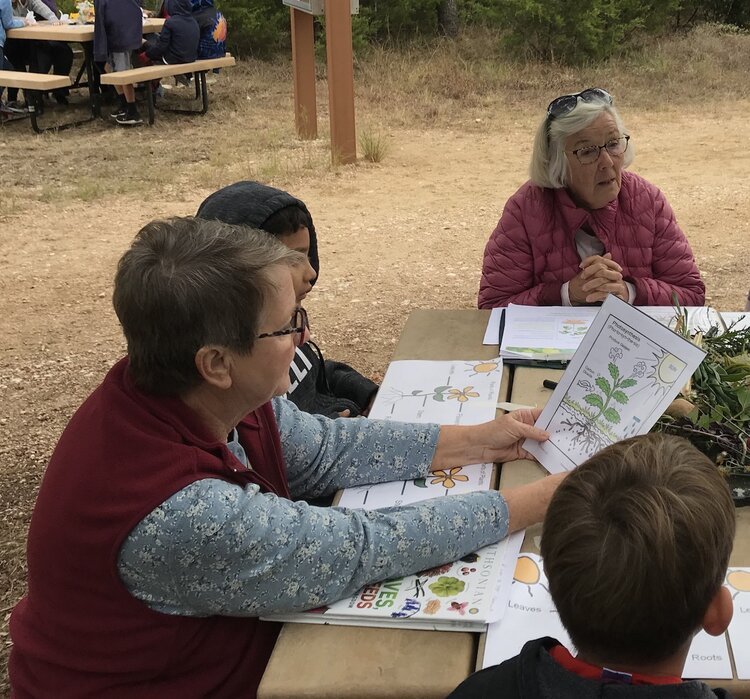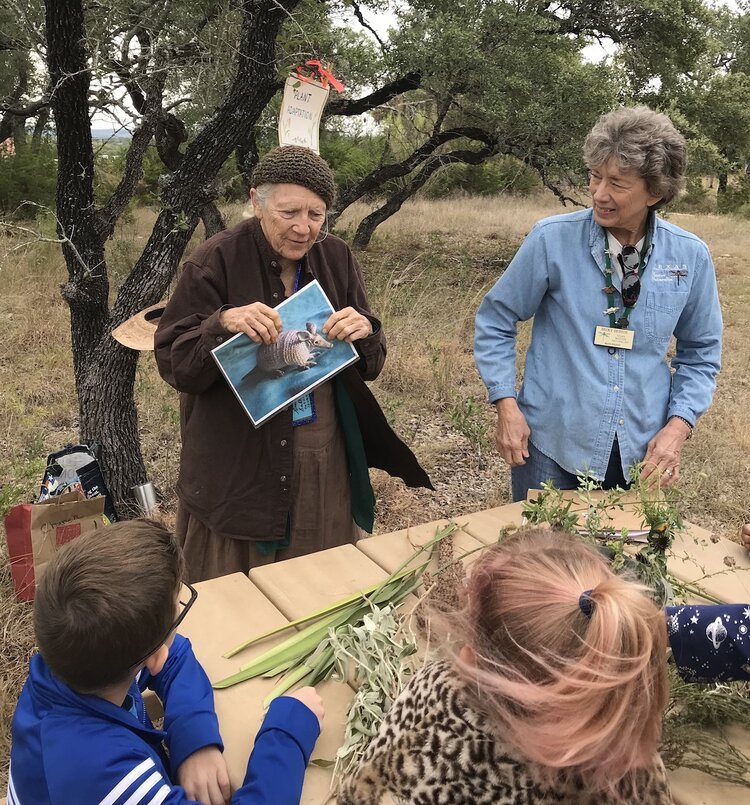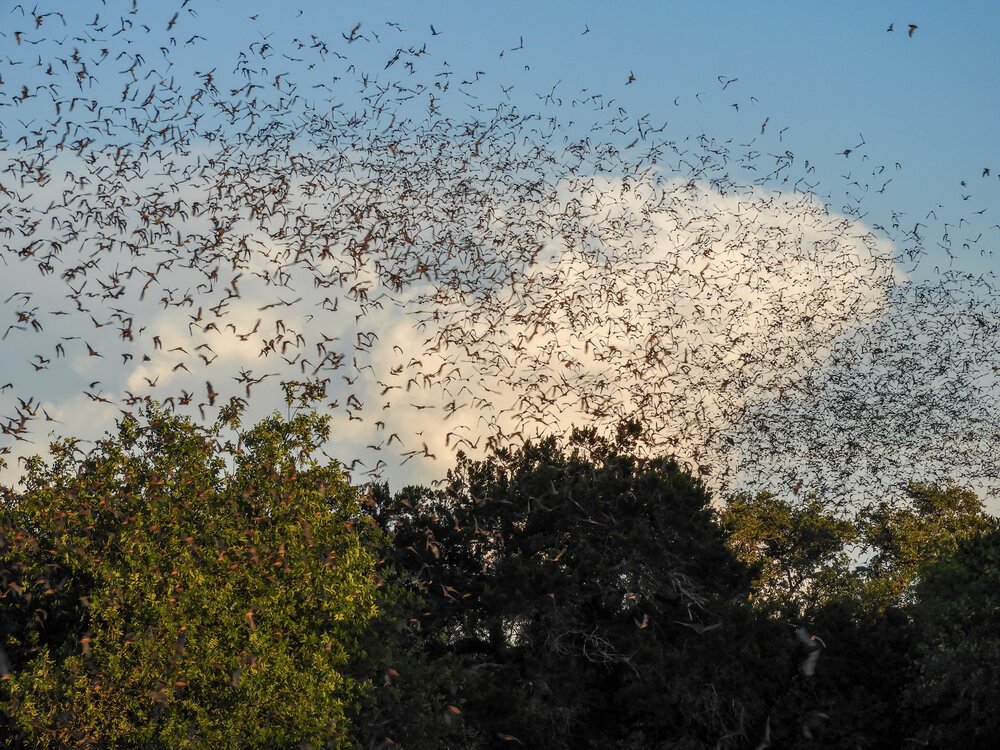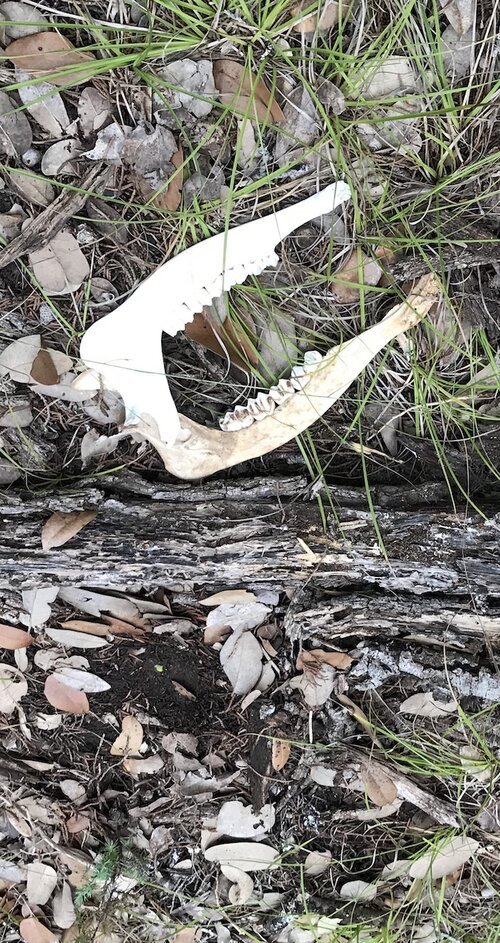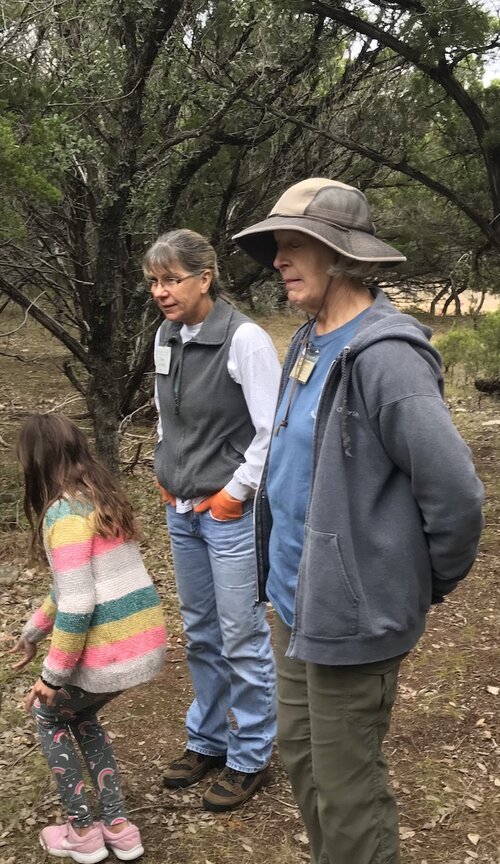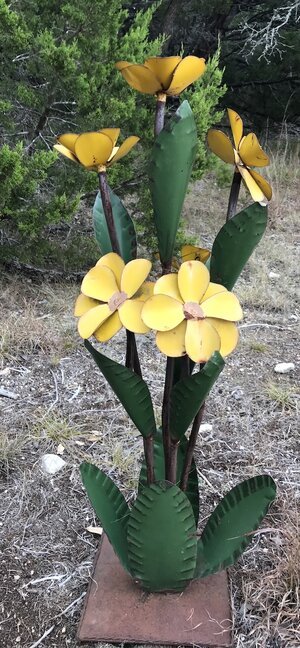The Hays Humm - November 2019
Tom Jones - Betsy Cross - Constance Quigley
THE NEWSLETTER OF THE HAYS COUNTY CHAPTER
TEXAS MASTER NATURALISTS
Monarch Migration - Eva Frost
"Going batty over HCMN!" - Lauren and her friend, Batman
LAUREN YOUNG
About Myself: I’m a proud Texas native. I was born and raised in Fort Worth. I graduated valedictorian from high school. I received my B.S. Biology (Marine/Field Science) and M.S. Biology (Coastal Ecology) from Texas A&M University – Corpus Christi (Go Islanders!). In 2008, I moved to Austin to work as a natural resource specialist for the Texas Commission on Environmental Quality. In 2018, I became an environmental specialist for the Texas Department of Transportation. I wear many hats, but lifelong science nerd is my favorite one. I graduated with the 2015 Cypress HCMN training class. In 2018, I transferred to the Capital Area MN chapter, but you couldn’t keep me away too long. As of July 2019, I am proud to be back with HCMN.
You May Not Know: I have been an active volunteer since my childhood. I am so thankful that my mother exposed me to volunteering and helped to shape my commitment to service. Highlights include: equestrian therapy, animal rehabilitation (where I fell in love with sea turtles and became a turtle hugger), marine mammal rescue, dog fostering, and Lymphatic Education & Research Network.
FAV Master Naturalist Activity: Too many amazing opportunities to choose from! My favorite volunteer activity is anything related to education and outreach (Lady Bird Johnson Wildflower Center, bats, Jacob’s Well Nature Center, Butterfly Festival, training committee…and the list goes on and on). My favorite experiences are field trips to Selah, Bamberger Ranch Preserve; visiting Bracken Cave for the first time; and attending the TMN annual meetings. My favorite memories are those made with my sister from another mister Mary O’Hara (’15, best class ever).
Bird you most identify with and why: I feel like I most relate with the Roseate Spoonbill, as we have a lot in common. I spent several years living along the Texas Gulf Coast, enjoying the bays, estuaries, and marshes. As a Pisces, I love having my feet wet. We both enjoy seafood. I am known for my “colorful” personality. We are both not afraid to stand out in a crowd. Highly social, I enjoy hanging out with the flock (especially my TMN tribe).
CHRISTINE MIDDLETON
About Myself: When I decided to train as a Master Naturalist in 2010, I didn't realize my activities would mostly revolve around water. One of my first volunteer activities was demonstrating the watershed and aquifer models for Blanco third graders out of which grew a year of research leading to presentations on protecting and conserving water. I am still doing them with Larry Calvert. Then, just before the 2015 Memorial Day flood hit, I attended a riparian workshop which led to working with Texas Parks and Wildlife and Treefolks in distributing plants designed to jumpstart recovery. In turn, that led to working directly with landowners through a variety of activities including site visits, seed giveaways and a periodic newsletter that is distributed to over 150 e-mail addresses. I also recently took on the role of Outreach Community Liaison for the Wimberley Valley.
You May Not Know: Before my passion turned to water, telecommunications was my focus for over 40 years.
FAV Master Naturalist Activity: I have loved them all. But there is nothing better than exploring a piece of property with a riparian landowner and assisting in their efforts to become a better land steward.
Bird you most identify with and why: I don’t have one. Rather it is all the different kinds of birds that come to my feeder and entertain me every morning as I'm eating breakfast.
I had the pleasure of attending a presentation about bats at the Wimberley Village Library on September 6, 2019. The presenter was Danielle Cordani, a recent graduate of Texas State, accompanied by Jacob Rogers, currently in the graduate program at Texas State. Her topic was a general overview of bats followed by a very interesting discussion of threats to these wonderful creatures and what we can do to help. This article summarizes her presentation.
Bats are in the order Chiroptera, which means “hand wings”. The second largest order of mammals, bats comprise about 20% of all classified mammal species worldwide, with over 1,200 species (~Wikipedia). The U.S. has 47 species, and Texas boasts the most within one state at 33 species documented.
Bats are quite beneficial for pest control (most are insectivores), pollination (especially the agave – the tequila industry relies heavily upon bats!), and seed dispersal (fruit-eating bats). Some are carnivores and eat fish and frogs. Of course, most people are also familiar with the vampire bat, which consumes blood, mostly from cattle.
Many bats are social animals and live in very large colonies. The largest known colony in the world is right here in Texas at Bracken Cave Preserve (Comal County). The population there is estimated at 15 million Brazilian free-tailed bats and is also the largest concentration of mammals in the world. There are very well-known colonies in Austin and Wimberley as well.
Bat Facts - Texas A&M Agrilife.org
Of the 33 species of bats known to live in Texas, 11 can live near humans and transmit rabies. Six species of colonial bats are known to occupy structures in Texas:
Big brown bat (Eptesicus fuscus)
Cave myotis (Myotis velifer)
Eastern pipistrelle or tri-colored bat (Pipostrellus subflavu)
Evening bat (Nycticeius humeralis)
Mexican free-tailed bat (Tadarida brasiliensis; subspecies: T. b. Mexicana and T. b. cynocephala)
Southeastern myotis (Myotis austroriparius)
Five species of solitary bats have roosted in buildings in Texas:
Eastern red bat (Lasiurus borealis)
Hoary bat (Lasiurus cinereus)
Northern yellow bat (Lasiurus intermedius)
Southern yellow bat (Lasiurus ega)
Seminole bat (Lasiurus seminolus)
Bats are highly beneficial native mammals:
Some bat species eat insects and consume up to their weight in food each night. A colony of bats can eat literally tons of insects every night. Bats also consume insects that damage crops. Research has shown that free-tailed bats in South Central Texas may save farmers up to $1.7 million a year by consuming significant numbers of agricultural pests.
Other bats feed on nectar and are important pollinators, especially in rainforests.
Some bats feed on fruits and disperse the seeds. More than 300 species of fruits depend on bats for pollination or seed dispersal; fruits pollinated by bats include avocadoes, bananas, carob, figs, mangoes, and peaches.
Bats serve as food for owls, hawks, falcons, opossums, and raccoons.
Bat waste, which is called guano, can be used as fertilizer.
Mexican free-tailed bats emerge from Bracken Cave near San Antonio, Texas
Credit: Michael Durham_Minden Pictures /Bat Conservation International
A lot of useful information about bats can be found at Bat Conservation International. Bat babies are the largest baby mammals at birth in proportion to their mother, weighing up to 1/3 her size! Imagine a human giving birth to a 30-pound baby! And some bats can reproduce twice per year.
Bat life expectancy is surprisingly long at 15-20 years. Unfortunately, there are many and growing threats to bat populations around the world. One of these is a relatively recent fungus known as white-nose syndrome (WNS). Bats that contract this fungus essentially starve to death, as they expend too much energy trying to groom the fungus from their faces and do not get adequate rest or food. WNS appears to have originated in Europe and has spread to the Eastern U.S. and has now been documented in Texas. While it has caused population decline, it does not appear to kill off entire bat populations. Many biologists are now studying this and trying to determine ways to combat the fungus without destroying bat habitats.
Another significant threat to bats, particularly in Texas, is wind energy. Texas is the leading producer (by three times) of wind energy in the United States. This is recognized as a great alternative energy source as it does not consume water and has no emissions. Unfortunately, wind turbines are very deadly to bats, killing as many as 50 bats per megawatt of energy produced (compared to the loss of 3-5 raptors killed in the same manner).
The reason for such loss of life is that bats are uncannily attracted to the wind turbines, drawn in and then struck by them. Scientists are currently trying to determine the cause of this attraction and working with wind energy companies to implement preventive measures to protect the bats. One method is smart curtailment, which involves shutting down the wind turbines at times when wind speeds are low. Unfortunately, this involves loss of revenues during downtimes and additional costs in stopping and starting the turbines.
A second method that has proven useful involves ultrasonic acoustics to deter bats from approaching the turbines. This is a battery of speakers mounted on the turbine that emit sound frequencies that confuse the bats’ echolocation and keep them away from the turbines. The big challenge to bat conservationists is establishing some regulatory mechanism that will require using such preventive methods. Most wind energy companies are concerned about the bat populations and are working with specialists to assist, but there are many smaller companies that don’t see the benefit in protecting bat species.
Many organizations are working toward increasing awareness of bats and their benefits to our natural areas and even agriculture. Danielle’s presentation offered some great information about bat behavior and the variety of species that we have in Texas. As with most animals that coexist with humans, bats contend with many threats in addition to their natural predators (raptors, snakes, raccoons). As master naturalists and property stewards, we can help by combatting myths about bats, increasing awareness of their habitat needs, and supporting research about these great flying mammals.
Links to learn more about bats and bat houses.
Bat House Builder’s Handbook. Learn more about attracting bats to your property and building your own bat house.
Another great resource is this article, which discusses the benefit of including a water feature: https://www.nrcs.usda.gov/Internet/FSE_DOCUMENTS/nrcs143_009962.pdf
If implementing a water source, a wildlife escape ramp is highly suggested for bats: https://www.nrcs.usda.gov/Internet/FSE_DOCUMENTS/16/nrcs143_022151.pdf
Danielle Cordani (Vice President) and Jacob Rogers (President) are with the Bat Association at Texas State.
Finally, Texas Ag Life has lots of great information about bats.
WHY A PRESCRIBED FIRE?
This prescribed fire is part of a long-term prairie restoration project and is intended to reduce wildfire danger and improve ecosystem health by removing invading shrubs, consuming dead and downed vegetation, reducing the number of exotic species, and enhancing the health and diversity of the native plant community. Historically, fires were a naturally occurring process that native plants and animals adapted to. Fires shaped the landscape, creating fire- adapted ecosystems such as prairies.
Westcave's main goal of controlled fires is to create a native prairie restoration demonstration area. Change happens slowly, Westcave's prairie is dominated by King Ranch Bluestem, a non-native, invasive grass species. Through the use of periodic controlled fires and re-vegetating the area with native grass seeds and flowering forbs, this prairie is being restored to a more native and diverse state. A healthy prairie is better able to support a wide variety of pollinators and other fauna that rely on native grasses and forbs for food. For instance, the iconic monarch butterfly relies exclusively on native milkweed plants, found in prairies, for their survival.
Boo Hole at Blue Hole
Outreach Team News
"I'm enjoying these beauties!"
Nannette Lucas
"I think it was October 14th and 15th, a bunch of them showed up!"
Eva Frost
Among plant groups the lily family (Liliaceae) was until recently a large, diverse family with as many as 4,950 species spread across the world. The development of genetic analysis has given taxonomists new insights into relationships among plants, and this cosmopolitan family has now been reorganized into new families and subfamilies. The accepted authority for plant taxonomy in the U.S., the Integrated Taxonomic Information System (ITIS-North America), defined the Order (the taxonomic group one level above family) Liliales under the Superorder Lilianae to replace Liliaceae. The basic features common to all species in the new system remain that they are monocot perennial herbs.
Whatever new group they may now be in, members of the erstwhile Liliaceae may have bulbs, rhizomes, or fleshy tuberous roots, with leaves growing either from the base of the plant, or as a tubular sheath surrounding the stem, or reduced to scales clinging to the stem. Some are commercially important as food sources (onions, garlic, leeks, asparagus) or in the horticultural trade for their large and attractive flowers, while others can produce lethal toxic alkaloids.
The new family Melanthiaceae (Bunchflowers) includes the small genus Schoenocaulon, (pronounced skee-no-KAW-lon) which includes ten species native from the southern U.S. south to Peru. The genus name comes from Greek roots meaning a reed or rush-like stalk. Three species occur in the U.S. with two in Texas, both with rather limited distributions and sometimes called Green Lilies. Schoenocaulon texanum, the Lily of Texas, occurs from near Corpus Christi in a band stretching across the southern Edwards Plateau westward toward the Pecos River and into southern New Mexico, as well as into northern Mexico. It can be found in limestone soils in rocky grasslands and openings in oak-juniper woodlands; it likes full sun but tolerates partly shady areas under scrubby vegetation.
Although often called the Green lily or Sabadilla, the accepted common name in botanical records is Texas Feathershank. Texas Feathershank grows from bulbs one to two inches in diameter; stems are from six to 22 inches tall and are bare below the flowering raceme which covers the top two to 12 inches. The leaves are long (up to 24 inches), narrow (less than one inch), and all arise from the base. The inflorescence is a dense cluster of flowers that cling to the stem with no or very short pedicels; individual flowers are small; the bracts at the base of the flowers may be tinged with purple while flower petals may be greenish yellow with red tips. Flowers appear in spring and early summer depending on the amount and timing of rains. Texas Feathershank grows well from seed but is slow growing; in years with insufficient rain, very few seeds may reach maturity.
The description of record by which the species was classified was published in 1853 in the journal Linnaea by the German botanist Georg Heinrich Adolf Scheele (1808-1864), who received four plants collected by Ferdinand Lindheimer in Texas in 1846.
We discovered two Texas Feathershank plants in thin limestone-derived soil on a dry, rocky slope, with full morning sun but shaded in the afternoon. We fenced them against deer and over the years they have persisted but have not spread beyond their original bases. We collected a few seeds one year and planted them in new areas; we have one new plant so far.
Sources: Shinner & Mahler’s Illustrated Flora of North Central Texas, 1999; Manual of the Vascular Plants of Texas, Correll & Johnston, 1979; Flora of North America v. 26, p. 79 (online database); Monograph of Schoenocaulon, Robert Roland Brinker, Annals of the Missouri Botanical Garden, v. 29 (1942), p.288; Lady Bird Johnson Wildflower Center Plant Database; iNaturalist (for documented locations).
The Wimberley Outdoor Educator Team led the Jacob’s Well Elementary School 2nd grade students on a plant field trip. The team of volunteers set up education stations to highlight plants. The stations included: plant adaptations, walk in the woods, play imitating the plant life cycle, plant parts and plant flowers.
HCMN Participating: Becky Denton, Connie Boltz, Doray Lendacky, Irene Bonde, Jamie Clark, Jean Richmond, Lauralee Harris, Leigh Peterson, Paula Glover, Sarah Carlisle, Susan Evans, Tom Jones, Bob Adkins, Tina Adkins
Also Supporting: Gracy Belle Broussard



